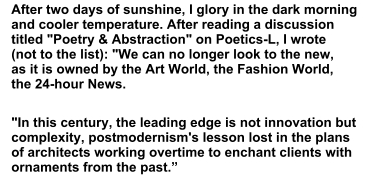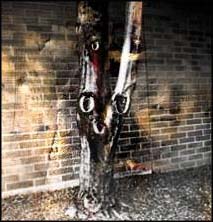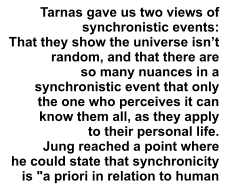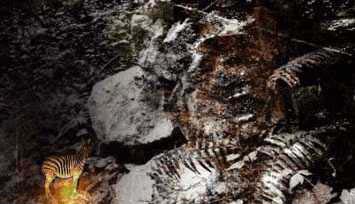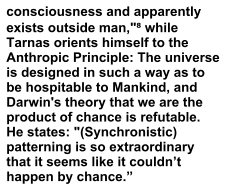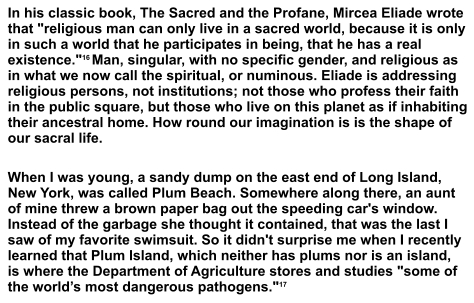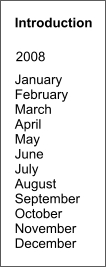
|
|
Earlier in our evolution, when we lived closer to our animal senses, detected as traces traveling between dimensions, deities were an integral part of our world. We see evidence of this in some paintings discovered in the caves of southern Europe, and in ancient petroglyphs found on several continents. Animals are still aware of these shadow deities. Our neuro-detectors of these deities still function in the rituals of shamans, in various meditation practices, and with the ingestion of psychedelic substances that ethnobiologist Wade Davis calls "sacred medicines."3 Following winding passages until reaching galleries of paintings united to the curvature of the rough cavernous walls, I could almost forgive the pogroms, inquisitions, genocides, the countless massacres and wars that followed the explosion of human artistic creativity. "'What we make' and 'what (we think) we are' evolve together; emergence can operate as an ethical dynamic as well as a technological one. Realization arrives not in an instant but in successive cycles of awareness, each building on what came before."4 It seems that the more I want to know, the more what I need to know slips away. Knowledge, gnosis, is like a fish a wild fish "jostling and surging against the current in fits and starts."5
May 4. After writing all morning, I leave my apartment and walk downtown, stopping at a table by a closed restaurant to read. While Mt. hood still wears a white coat draped across its shoulders, in the city a sudden spike of heat makes me lethargic. Have I been reading so much that nothing seems important anymore? I close the book and walk to the library, frightened of my sudden ennui. After browsing through books on art criticism, I wonder what the New York Art World would be today without the influx of talent from Europe on the cusp of WWII. Sometimes madness—Hitler, Stalin, Mao Tse-tung—can inadvertently cast forth light that is brighter than its shadow.
It seems strange to think of psychosis as having a center. Centers are settled, individualized, while psychosis is like being lost in midst of an electrical storm without being grounded. If madness is heroic, it is heroically tragic. Walking down the library's steps, I wondered if there are still centers; or have all the poles been cut down in order to create the illusion of a smooth line of flight? . 6. Just before I woke up this morning, I dreamed I was frantically tugging on a bright red blanket, trying to stop it from disappearing into a black void that's over the edge of the bed. I thought, "Could it be that we die into another dimension?" Later in the day, I thought: Death can't figured in a dimensional perspective, as this leads us out of the mystery and into metaphysics, which is what makes Western religions untenable. Not-knowing is where I want to be at the end.
10. Would I be wrong if I call synchronicity an uncanny connectivity with archetypal patterning? Could the nonhuman world be living comfortably with these continuously unfolding coincidences, our awareness of them a haunting from our past, the ghost in our genes? Synchronicity can also be, as Richard Tarnas puts it, "extraordinarily transformative." Dr. Tarnas, the founding director of the Ph.D. and Masters's program in Philosophy, Cosmology, and Consciousness, at the California Institute of Integral Studies, in San Francisco, was this month's speaker at Oregon Friends of C.G. Jung. His talk was titled, "Synchronicity and its Implications." The example from Jung's writing that Tarnas brought to the forefront was "The Case of the Golden Scarab," my emphasis making it sound like the title of a mystery novel from an era when revenants rapped on tables, blew on curtains, and rattled invisible chains. Synchronicity, indeed, is a kind of haunting.
Having a flare for the dramatic, Dr. Tarnas said, "Catching the insect, Jung turned to his patient and said, 'Here's your golden scarab,'" shocking the woman, whose animus, Jung continues, "was steeped in Cartesian philosophy and clung so rigidly to its own idea of reality that the efforts of three doctors—I was the third—had not been able to weaken it. Evidently something quite irrational was needed which was beyond my powers to produce."7 Upon hearing this story, what first appeared to me was a picture of the therapist grabbing the insect in mid-air like a samurai catching a fly between his chopsticks. This is also the spirit in which Dr. Tarnas lectures, seemingly plucking ideas out of empty air, although his insights have been well thought out and annotated. Jung goes on to say: "Synchronistic events rest on the simultaneous occurrence of two different psychic states. One of them is the normal probable state (i.e., the one that is causally explicable), and the other, the critical experience, is the one that cannot be derived causally from the first." In a 1952 interview with Mircea Eliade, the great scholar of Comparative Religion, Jung said that he had "established that (synchronicity) closely resembles numinous experiences where space, time, and causality are abolished."8 Indeed, the golden scarab returns us to the sarcophagus of Ancient Egypt's burial of its pharaohs.
It is true that chance may not be imaginative enough for the "incalculable infinity of causes and effects."10 Theoretically at least, time can flow in either direction: an effect may occur before its cause. When physicists dream of strings that vibrate in tune with their dimension, "Reality / is like a contemporary string / quartet: / the first violinist puts on a crow's head."11 Astrology: figuring that systematically attracts the planets into humanity's orbit, is central to Tarnas' work.12 Years ago, when I was still a "starry-eyed" poet, a statement such as, "The universe loves to be appreciated," would have enthused me. Even today, my mind returns to when "the arrangement of Time would be described by astrology, by the animal images of the ancient lunar calendar,"13 and I believe that the Mysteries are still afoot. However, our future on this planet is in such dire straits that by continuing along the same path we are running against ourselves. . 16. A warm overcast morning. The temperature is predicted to spike 25 degrees above normal before slowly retreating. It was like this eight years ago, when I rode a heat wave from New Mexico across the desert. In Sparks, Nevada, a motel manager said, "It was cool here last week." Last century, too. In the forest, hillsides burdened with runoff feel poised to slide, trees and all, onto the narrow trail. Perfectly blended from plants around me, fragrances fill my lungs with the scent of other places. Why can't I find air to breathe that isn't saturated with memories?
Stepping
carefully on slippery muddy stones and roots down to the creek's
bed
swollen with spring thaw, mountains slowly darkening in the distance,
to a rock that sports a young plant growing from its top like
a plume—reminiscent of a Tibetan Buddhist belief that at
the time of a person's death consciousness leaves through a hole
in the crown, to begin
its
journey back, perhaps not as a human being.
A new kind of brain had emerged from the old, with a mind not only orbiting its own survival. One morning, awakening to the chill of death, Time was born, wrapped in a gauzy shroud.
18. Critics
look to the poet’s “I” usually without understanding
that even with the best of Confessional Poetry this I is not
an invitation to a private showing, but to a public gathering.
The manner of the poet’s
I is one of sustainable curiosity, of constantly questioning its motives
and moves, of balancing on a metaphoric string that is loosely strung.
Every word has a history that when written becomes the writer's history
too. To quote Edmond Jabès, “You are the one who writes
and the one who is written.”15
I honor Jabès because at a time when I had given up on writing poetry, he showed me that original work could still be done. Also because he knew that an artist learns his or her path by questioning its direction. Thus, as a Jew, he found "God" in the book he was writing, not in one that had already been written. 21.
Now five states are competing for a new National Bio and Agro-Defense Facility (NBAF) that would take over Plum Island's work. Considering that cities or agricultural areas are not desirable places to experiment with "potent microbial cultures," a biology professor from Kansas State University recommends, “putting the lab in a desert or back on Plum Island.”17 24. Driving up the steep hill that climbs above Santa Fe’s chic art galleries and faux adobe buildings, north toward Taos Pueblo's sacred Blue Lake, a left turn through a sprawling junkyard led to the ruins of a kiva where secret rites were held beneath the desert's dissident floor. Now a depression strewn with fragrant shards of cedar, I would sit by it for hours, while cold restless breezes whistled through the precarious chemistry of my existence.
This morning, I walked toward the forest through a cloud of light drizzle, but before reaching there, I segued to the clearing of the Oregon Holocaust Memorial. Bronzed mementoes scattered before the wall of the Warsaw Ghetto, the Berlin Wall, the wall Israel is building to parse itself from its neighbors, the walls America is building between neighborhoods in Baghdad....a suitcase, a violin, a baby crying on a stone bench, a single shoe.
Suddenly I remembered it's Memorial Day weekend, thus my attraction to the Holocaust Memorial. I began brooding again over the mystery of synchronicity, and how "the collisions at LHC could spray out strange new kinds of matter, unfurl hidden dimensions of space, even generate tiny glowing reenactments of the birth of the universe,"2 before continuing my journey into the forest.
1-
Bashō, M. Knapsack Notebook. (1667-68).
2- Walker, G. "The Biggest Thing in Physics." Discover Magazine. August 2007. a line, a boundary: R. Buxton, Imaginary Greece. Cambridge, England.,1994. 3- Davis, W. Interview with Jessica Ruvinsky. Discover Magazine. April 2008. 4- Hayles, N. Katherine. My Mother Was a Computer. Chicago, IL, 2005. 5- Adram, D. “Reciprocity.” In, B.V. Foltz and R. Frodeman, Editors, Rethinking Nature: Essays in Environmental Philosophy. Bloomington, IN, 2004 6- Perry, J.W. The Far Side of Madness. Englewood Cliffs, NJ, 1974. 7- Jung. C.G. "Synchronicity: An Acausal Connecting Principle." In, C.G. Jung and W. Pauli, The Interpretation of Nature and the Psyche. New York, NY, 1955. 8- Jung, C.G. In, W. McGuire and R.F.C. Hull, Editors, C.G. Jung Speaking: Interviews and Encounters. Princeton, NJ, 1977. 9- Rilke, R.M. From, "The Sonnets to Orpheus." A. Poulin, Jr., Translator. 10- Cage, J. Silence. Cambridge, MA, 1969. 11- Sze, A. From, "Dazzled." 12- Tarnas, R. See, Cosmos and Psyche. New York, NY 2006. 13- Thompson, W.I. The Time Falling Bodies Take to Light. New York, NY, 1981. 14- Narby, J. Intelligence in Nature. New York, NY, 2006. (He is addressing Dr. Anthony Trewavas of the Institute of Cell and Molecular Biology, Edinburgh.) 15- Jabès, E. The Book of Questions: The Book of Yukel, Return of the Book., Middletown, CT, 1964. 16- Eliade, M. The Sacred of the Profane. New York, NY, 1959. 17- Cox, S. “Bidding for Biohazards: The Madness of Bushenomiocs.” www.alternet.org, 29 March 08. 18- Soseki, M. From, “Old Creek.” In, Sun at Midnight., San Francisco, CA, 1989. W.S. Merwin and S. Shigematsu, translators. |


